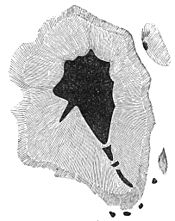made its appearance at about the time the great comet was in perihelion, in September last, and broke out on the portion of the solar globe which was nearest to the comet at that time, has been fancifully called the "black eye that the comet gave the sun." There were other spots visible at the same time and they also were ascribed by some to the
 Fig. 4. influence of the comet. Some plausible reasons have been shown in favor of this view, and Professor Kirkwood's opinion that the great sun-spots of June, 1843, were caused by the large comet of that year has been freely quoted in support of it. Of course, the question whether this particular spot and its companions originated in some disturbance caused by the comet, whether by the fall of meteoric masses following in the comet's track or otherwise, can not be settled either way by positive evidence at present. But, while there are improbabilities in the way of the hypothesis, it may, at least, be said that, if any comet could produce a sun-spot without actually tumbling into the sun itself, the comet of last year ought to have been able to do it, for, as is known, it almost brushed the sun in its perihelion swing.
Fig. 4. influence of the comet. Some plausible reasons have been shown in favor of this view, and Professor Kirkwood's opinion that the great sun-spots of June, 1843, were caused by the large comet of that year has been freely quoted in support of it. Of course, the question whether this particular spot and its companions originated in some disturbance caused by the comet, whether by the fall of meteoric masses following in the comet's track or otherwise, can not be settled either way by positive evidence at present. But, while there are improbabilities in the way of the hypothesis, it may, at least, be said that, if any comet could produce a sun-spot without actually tumbling into the sun itself, the comet of last year ought to have been able to do it, for, as is known, it almost brushed the sun in its perihelion swing.
This great spot, however, is interesting on another account. The cut represents its appearance on October 1st, when it had reached about its greatest development. On October 2d there was a magnetic storm which was felt principally in Europe. The storm was very much less severe in its effects upon the telegraphs than those of April and November, but it was accompanied by the appearance throughout England, Scotland, and Western Europe of a most beautiful aurora.
In conclusion, it may be said that, while the evidence furnished by the great magnetic storms of last year was hardly needed to complete the chain of proof of the intimate connection between solar outbursts and the magnetic conditions prevailing upon our globe, yet this evidence was of such a striking character that it must rank among the most interesting of all that bears upon this question. It is, perhaps, worthy of remark that the period of sun-spot maximum through which we have just been passing has also furnished a good deal of evidence in favor of the views of those who think a connection can be traced between sun-spots and the weather. It is only necessary to point to the facts that 1881 and 1882, as well as the beginning of 1883, have been remarkable for cyclones, tornadoes, storms, and floods, and
